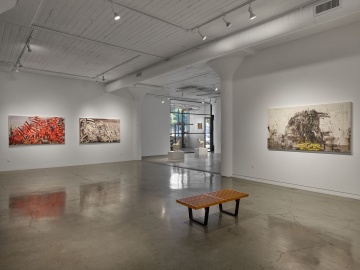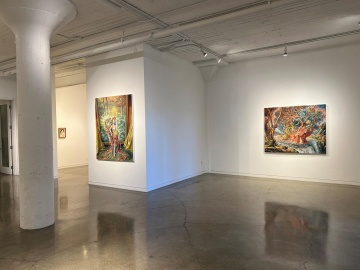Catharine Clark Gallery
248 Utah Street
San Francisco, CA 94103
415 399 1439
San Francisco, CA 94103
415 399 1439
Established in 1991, Catharine Clark Gallery exhibits contemporary art in all disciplines. In response to each exhibition, the gallery presents changing exhibits of video and time-based genres within a dedicated media room. Catharine Clark Gallery represents an acclaimed roster of international artists, including Stephanie Syjuco, Marie Watt, Nina Katchadourian, Jen Bervin, Arleene Correa Valencia, Lenka Clayton, Sandow Birk, Julie Heffernan, Wanxin Zhang, and Masami Teraoka, among others. The gallery also co-publishes and distributes original multiples with Mullowney Printing, such as linocuts, gravures, and etchings by Alison Saar, Marie Watt, Masami Teraoka, and Sandow Birk.
The gallery's program has garnered critical attention from the New York Times, Artforum, Art in America, SF Chronicle, and Hyperallergic, among other publications. Works by gallery artists are in the permanent collections of dozens of major international institutions including the Tate, Whitney Museum of American Art, The Cantor Arts Center, Metropolitan Museum of Art, Museum of Modern Art, San Francisco Museum of Modern Art, Fine Arts Museums of San Francisco, J. Paul Getty Museum of Art, Los Angeles County Museum of Art, the Hammer, San Jose Museum of Art, the Pennsylvania Academy of Fine Arts, Walker Art Center, Portland Art Museum, and the Blanton Museum of Art.
In 2016, Catharine Clark founded BOXBLUR, an initiative to bring visual and performing art into dialogue within the gallery. Artists and performers/collaborators include Rufus Wainwright, Shinji Eshima, EOS Ensemble, Catherine Galasso, Benjamin Freemantle, Angelo Greco, Adji Cissoko, Michael Montgomery, Emma Lanier, Cauveri Suresh, Margaret Jenkins Dance Company, Monique Jenkinson/Fauxnique, Indira Allegra, Kambui Olujimi, Jen Bervin, and Shimon Attie, among many others. BOXBLUR is a fiscally sponsored project of Dance Film SF, and the annual SF Dance Film Festival screens films at our location each year. Additionally, Dance Film SF and BOXBLUR co-host live performances and film presentations curated in response to the ideas in the exhibiting visual artists' work.
Located within San Francisco's emerging DoReMi arts district (comprised of adjoining neighborhoods Dogpatch, Potrero Hill, and the Mission), Catharine Clark Gallery is situated in proximity to leading arts venues such as California College of the Arts (CCA), the CCA Wattis Institute for Contemporary Arts, the Museum of Craft and Design and Minnesota Street Project. The gallery also shares a building at 248 Utah Street with Hosfelt Gallery.
In 2023, the gallery expanded into the vacant adjacent space, increasing its footprint to 9200 square feet. Part of the additional space is dedicated to the ongoing presentation of works on paper, prints, and photographs. Adjacent to the exhibition galleries is EXiT, a jewel-box art and artist's book boutique presenting publications and projects realized at places like Arion Press and Crow's Shadow---organizations with whom we have recently created partnerships. EXiT is a different model for art, artist book, and art book presentation and is focused on art and printmaking education, book signings and workshops, and accessible prices for emerging collectors.
Artists Represented:
Chester Arnold
Jen Bervin
Sandow Birk
Lenka Clayton
Arleene Correa Valencia
Timothy Cummings
Chris Doyle
Al Farrow
Julie Heffernan
Laurel Roth Hope
Andy Diaz Hope
Nina Katchadourian
LigoranoReese
Deborah Oropallo
Stacey Steers
Stephanie Syjuco
Josephine Taylor
Masami Teraoka
Amy Trachtenberg
Katherine Vetne
Marie Watt
Wanxin Zhang
Works Available By:
Shimon Attie
Bill Jacobson
Lenka Clayton + Phillip Andrew Lewis
Robert Colescott
Kevin Cooley
Ken Goldberg
Charles Gute
Michael Hall
Malia Jensen
William Kentridge
Bradley McCallum
Deborah Oropallo + Andy Rappaport
Elyse Pignolet
Alison Saar
Vincent Valdez
Kara Walker
Imin Yeh
Arleene Correa Valencia
"Codice Del Perdedor / The Losing Man’s Codex"
May 31, 2025 - July 19, 2025
The title of the exhibition is Codice Del Perdedor / The Losing Man’s Codex, in which all the works are made on the same Amate paper that our ancestors used to write their stories of migration. I’m particularly inspired by the Codex Boturini, which depicts the migration from Aztlán to the creation of Mexico-Tenochtitlán. This codex illustrates mothers carrying their children on their backs while on the search for safety and home. When I saw this, I was reminded of how our story of migration is a universal experience that never ends. The Losing Man’s Codex address the battle between good and bad, and everyone who stands between the two sides.
When I was younger my father told me a story of how losing is a noble act, one to be proud of, one that gifts us with joy and the opportunity to learn- a horizontal state of being in which all who lose stand together in community, while that who wins stands alone. I made this work with the intention of reflecting on the current state of our community being hunted down by ICE, but also to celebrate our strength and resilience- to take pride in the beautiful ways in which we can come together and protect each other.
Zeina Barakeh
"CYBOTAGE"
March 22, 2025 - May 24, 2025
CYBOTAGE is a solo exhibition where art, biology, global security, and social science converge. Named after its central body of work, this series of animated digital colossi probes the ethical dilemmas of human enhancement technologies—sparking dialogue on their impact on society and the environment. Inspired by the colossal guardian statues of Ancient Egypt’s Abu Simbel, these figures, constructed from MRI-like scans overlaid with mapping systems, stand as “guardians” of cyberspace, projected onto landmark facades, skyscrapers, or displayed indoors.
Drawing from the legacy of Ancient Egyptian colossi, CYBOTAGE reflects on humanity’s shifting relationship with technology—from the permanence of carved stone to the ephemeral nature of digital pixels. Reimagining the colossus as a “deity” of the Internet age, it questions our dependence on cyberspace as a modern temple and the unseen forces that govern and protect our digital existence.
CYBOTAGE invites viewers to examine the intersections of human enhancement, cybernetics, and data surveillance with body autonomy, longevity, and environmental sustainability. It raises urgent questions about who will have access to technological upgrades, how these advancements could reshape societal hierarchies, and what “equality” might mean in a future where the boundaries between human and machine continue to dissolve—particularly as the gap between enhanced and non-enhanced individuals emerges in both civilian and military spheres.
CYBOTAGE is the recipient of the 2025 Leonardo-ASU Seed Grant, and supported by the 2024 SF Bay Area Artadia Award.
Sandow Birk, Michael Goldin, Charles Lee, Deborah Oropallo, Andy Rappaport, Stephanie Syjuco, Wanxin Zhang
"Rope and Revolver: Artists Respond to Frederic Remington's 'The Broncho Buster'"
January 18, 2025 - March 15, 2025
The exhibition’s title references the work of American artist Frederic Remington (1861–1909), whose paintings, sculptures, and bronzes glorified Manifest Destiny as a form of heroism and westward expansion into unceded territory as a “birthright” of White Americans. While largely understood in a cultural or art historical context, Remington’s work is closely tied to the political project of American imperialism. The works in Rope and Revolver are not a direct response to Remington, though many of the projects on view take the likeness of The Broncho Buster and dissect and parody its form. Instead, the seven artists featured in the exhibition take the ethos of Remington’s work as a point of departure to debunk the frontier narrative as a form of mythmaking. Through their respective mediums—video, photography, installation, sculpture, and painting—the artists in Rope and Revolver ask deep questions about what it means to be an American and how we can collectively imagine a more inclusive future.
Julie Heffernan
"Whether You Fall"
November 23, 2024 - January 11, 2025
Julie Heffernan’s "Whether You Fall" (North Gallery) explores the pervasive sense of malaise in the world and the larger forces that shape our lives. As Heffernan writes, “This particular malaise is evident not only in the stories we hear daily— whether in the media, around dinner tables, or in conversations with loved ones—but also in how remarkably new these stories are to history. They form an alarmingly different backdrop to human life: the sick trees in Yosemite, the yellow haze on Cape Cod from California’s burning forests.”
Wanxin Zhang
"California Artist, Too"
November 23, 2024 - January 11, 2025
Wanxin Zhang’s "California Artist, Too" (South Gallery) draws on his personal and artistic journey from Manchuria to California. Inspired by the Bay Area’s funk movement, Zhang blends its rebellious energy with personal memories and social commentary. Over the past two decades, clay has become not just his medium, but a conduit for his emotions, ideas, and reflections on both personal and societal experiences. The exhibition’s title cheekily riffs on Bay Area artist Robert Arneson’s iconic ceramic sculpture "California Artist" (1982) – held in the collection of SFMOMA – as a way to reimagine a space for himself in a Post War art historical lineage.
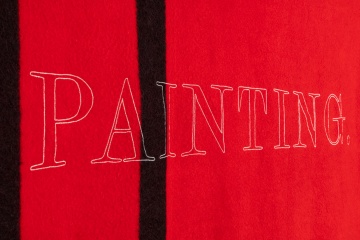
Marie Watt
"Telegraph"
September 21, 2024 - November 16, 2024
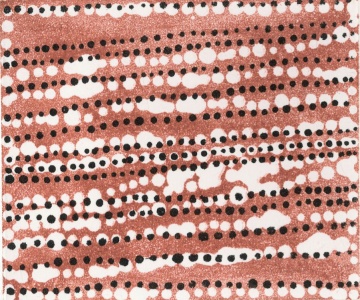
Ashwini Bhat, Chelsea Bighorn, Dorothy Napangardi, Esteban Ramón Pérez, Sara Siestreem (Hanis Coos), Carlos Villa, and Marie Watt. Media Room: Zeina Barakeh.
“The Sky You Were Born Under: Sharing Stories Through Abstraction”
July 13, 2024 - September 14, 2024
Image: Dorothy Napangardi, “Sandhill Country”, 2004. Color aquatint with sugar lift aquatint. Image size: 4 3/4 x 4 inches: paper size: 8 3/4 x 9 inches. Edition of 50. Published by Crown Point Press and printed by Dena Schuckit.

Amy Trachtenberg
“Listening Chamber”
July 13, 2024 - September 14, 2024
Image: Amy Trachtenberg, studio view of “Archive” and “Say alabaster, say paradise” 2024.

Michael Hall
“For Real Life”
May 11, 2024 - July 6, 2024
Michael Hall is a Bay Area artist and educator whose drawings, paintings, and videos examine the nuanced meanings of ephemera that surround us through observed, poetic daily moments, research of lost histories and connections formed through the exchange of information. He focuses on the act of recording, attempting to slow the inevitable march of time through mindful observation, patient rendering contrasted with the aleatoric aesthetics of “rabbit hole” research.
Image: Michael Hall, “Walking in Your Footsteps”, 2023. Oil on canvas with buttons, pins and QR code sourced link. 42 x 76 inches. Courtesy of the artist and Catharine Clark Gallery, San Francisco.
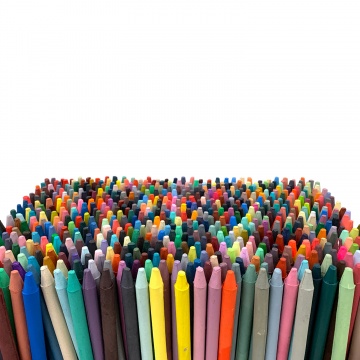
Imin Yeh
“A Salty Rainbow”
May 11, 2024 - July 6, 2024
Imin Yeh (she/her) is a project-based artist working with sculpture, installation, artist publications, and participatory projects. Her work expands our understanding of the role paper and print have played in the recording, copying, and spreading of the human story for more than a millennia. The projects use repetitive handcraft and mimicry as a strategy for exploring the issues around the unseen labor and production that lies behind our many unconsidered everyday objects.
Image: Imin Yeh, “A Thousand Crayons of a Unique Color”, 2021–2024. Acrylic paint on paper. Full collection 11 x 11 inches, each crayon is 3.5 x .25 inches. Courtesy of the artist and Catharine Clark Gallery, San Francisco.
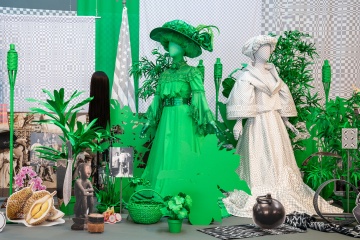
Stephanie Syjuco
“Dodge + Burn”
March 9, 2024 - May 4, 2024
San Francisco: Catharine Clark Gallery announces the opening of “Stephanie Syjuco: Dodge + Burn”, a survey exhibition of over 20 years of work by the acclaimed cross-disciplinary artist. On view March 9 – May 4, 2024, Syjuco’s exhibition encompasses both the North and South Gallery as well as the Media Room. Visitors to this expanded presentation will have the opportunity to engage with several important projects originally commissioned by institutions, such as “Dodge and Burn (Visible Storage)” (2019) and “Double Vision” (2021), which are being presented on the West Coast for the first time. The gallery hosts an opening reception on Saturday, March 9, 2024, from 1-3pm (remarks at 2pm).
Stephanie Syjuco (b. 1974, Philippines; lives in Oakland, California) works in photography, sculpture, and installation, moving from handmade and craft-inspired mediums to digital editing and archive excavations. Her projects leverage opensource systems, shareware logic, and flows of capital to investigate issues of economies and empire. Recently, she has focused on how photography and image-based processes are implicated in the construction of racialized, exclusionary narratives of American history and citizenship. Syjuco is frequently invited by museums and special collections to respond to materials held within their archives. “Stephanie Syjuco: Dodge + Burn” features work conceptualized in response to research conducted at the Smithsonian Institute, Amon Carter Museum of American Art, and the Missouri Historical Society, among other venues. Her exhibition reflects the breadth of Syjuco’s investigation into the history of image-making and its relationship to the white gaze.
Image caption: Stephanie Syjuco, “Dodge and Burn (Visible Storage)” from “Stephanie Syjuco: Rogue States” at the Contemporary Art Museum in St. Louis, MO, 2019. Wooden platform, digital photos and printed vinyl on lasercut wood, chromakey fabric, printed backdrops, seamless paper, artificial plants, mixed media. Overall installation: 240 x 204 x 96 inches. Edition of 3 + 2AP. Courtesy of the artist and Catharine Clark Gallery, San Francisco.
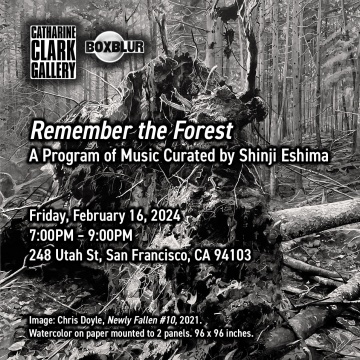
An evening of music curated by Shinji Eshima in response to Chris Doyle’s exhibition "You Should Lie Down Now and Remember the Forest" and Chester Arnold’s exhibition "Tributaries".
"Remember the Forest": A Program of Music Curated by Shinji Eshima.
February 16, 2024 - February 16, 2024
Reflecting on the work in Chris Doyle’s exhibition "You Should Lie Down Now and Remember the Forest" and Chester Arnold’s exhibition "Tributaries", BOXBLUR invited Shinji Eshima to curate a special program that evokes the ideas in both visual art exhibitions through music. Eshima’s program titled Remember the Forest features a work titled Logs (1966 by Paul Chihara) performed by Jon Lancelle, Michael Minor, Evan Hillis, Yuchen Liu, Carlos Valdez, Alexandria Kelley, Christopher Yick, Soren Davick, and Shinji Eshima, a work titled August 6th (1995 by Shinji Eshima), performed by Ani Bukujian and Michael Minor, as well as the monks from the SF Zen Center, who will chant as part of the evening’s performances.
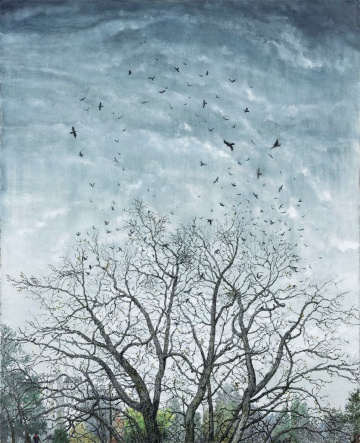
Chester Arnold
“Tributaries”
January 6, 2024 - March 2, 2024
Chester Arnold investigates the complexities of the human psyche through his contemporary landscape paintings littered with manmade debris. His compositions present skewed perspectives that often place the viewer at a remove, above unfolding narratives.

Chris Doyle
“You Should Lie Down Now and Remember the Forest”.
January 6, 2024 - March 2, 2024
“Every year in Maine, the forest loses some elders to the wind. Back in 2020 at the height of the Covid 19 pandemic, it seemed like more than the usual number of trees had been uprooted by storms and I found myself marveling at the new life springing from earlier fallen trees. During this unprecedented period of mourning for those lost in the time of Covid-19, these drawings of exposed root systems are a kind of memorial to those people who, now fallen, will continue to live on as sources of inspiration well beyond these seasons of loss. For each hero or mentor of mine who died of Covid, I made a drawing.” – Chris Doyle

 Back to all Member Galleries
Back to all Member Galleries



